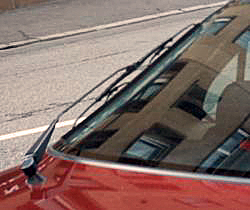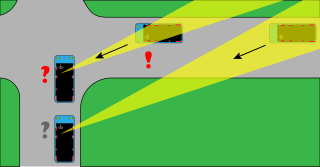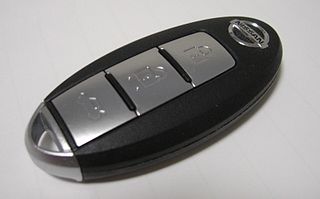
A windscreen wiper or windshield wiper is a device used to remove rain, snow, ice, washer fluid, water, or debris from a vehicle's front window. Almost all motor vehicles, including cars, trucks, buses, train locomotives, and watercraft with a cabin—and some aircraft—are equipped with one or more such wipers, which are usually a legal requirement.

A blind spot in a vehicle or vehicle blind spot is an area around the vehicle that cannot be directly seen by the driver while at the controls, under existing circumstances. In transport, driver visibility is the maximum distance at which the driver of a vehicle can see and identify prominent objects around the vehicle. Visibility is primarily determined by weather conditions and by a vehicle's design. The parts of a vehicle that influence visibility include the windshield, the dashboard and the pillars. Good driver visibility is essential to safe road traffic.

Smart glass, also known as switchable glass, dynamic glass, and smart-tinting glass, is a type of glass that can change its optical properties, becoming opaque or tinted, in response to electrical or thermal signals. This can be used to prevent sunlight and heat from entering a building during hot days, improving energy efficiency. It can also be used to conveniently provide privacy or visibility to a room.

Advanced driver-assistance systems (ADAS) are technologies that assist drivers with the safe operation of a vehicle. Through a human-machine interface, ADAS increase car and road safety. ADAS use automated technology, such as sensors and cameras, to detect nearby obstacles or driver errors, and respond accordingly. ADAS can enable various levels of autonomous driving.

The Holden Caprice is a full-size car which was produced by Holden in Australia from 1990 to October 2017. The similar Holden Statesman, which was also introduced in 1990 as a model below the Caprice, was discontinued in September 2010. Between 1971 and 1984, Holden marketed their long-wheelbase sedans under the Statesman marque.

A smart key is an electronic access and authorization system that is available either as standard equipment or an option in several car designs. It was developed by Siemens in 1995 and introduced by Mercedes-Benz under the name "Keyless-Go" in 1998 on the W220 S-Class, after the design patent was filed by Daimler-Benz on May 17, 1997.

Electrochromism is a phenomenon in which a material displays changes in color or opacity in response to an electrical stimulus. In this way, a smart window made of an electrochromic material can block specific wavelengths of ultraviolet, visible or (near) infrared light. The ability to control the transmittance of near-infrared light can increase the energy efficiency of a building, reducing the amount of energy needed to cool during summer and heat during winter.

A rear-view mirror is a, usually flat, mirror in automobiles and other vehicles, designed to allow the driver to see rearward through the vehicle's rear window.

A window film, sometimes called tint, is a thin laminate film that can be installed on the interior or exterior of glass surfaces in automobiles and boats, and as well as on the interior or exterior of glass in homes and buildings. It is usually made from polyethylene terephthalate (PET), a thermoplastic polymer resin of the polyester family, due to its clarity, tensile strength, dimensional stability, and ability to accept a variety of surface-applied or embedded treatments.

A passive infrared sensor is an electronic sensor that measures infrared (IR) light radiating from objects in its field of view. They are most often used in PIR-based motion detectors. PIR sensors are commonly used in security alarms and automatic lighting applications.

The Mercedes-Benz W221 is a chassis code of the fifth generation S-Class produced from August 2005 until June 2013.

A motor vehicle has lighting and signaling devices mounted to or integrated into its front, rear, sides, and, in some cases, top. Various devices have the dual function of illuminating the road ahead for the driver, and making the vehicle visible to others, with indications to them of turning, slowing or stopping, etc., with lights also indicating the size of some large vehicles.

The PACE Award is an annual award from Automotive News. The focus of the award is an innovation (i) developed primarily by a supplier, (ii) that is new to the automotive industry, (iii) that is in use, and (iv) that "changes the rules of the game". Awards have been given for products, materials, processes, capital equipment, software and services. A panel of independent judges from industry, finance, research, and academia choose finalists from the initial applicants, make site visits to evaluate the innovation, and then gather to select winners, independent of the sponsors. Winners to date include suppliers from Japan, Korea, China, the US, Canada, Brazil, Germany, France, Italy, Poland and other European countries. Among the most awarded companies over the years are BorgWarner, Delphi Automotive, Federal-Mogul, Valeo and PPG Industries as well as Robert Bosch GmbH, Gentex Corporation, and Siemens.

A side-view mirror, also known as a wing mirror, is a mirror placed on the exterior of motor vehicles for the purposes of helping the driver see areas behind and to the sides of the vehicle, outside the driver's peripheral vision.
The following outline is provided as an overview of and topical guide to automobiles:

A sun visor is a component of an automobile located on the interior just above the windshield. They are designed with a hinged flap that is adjustable to help shade the eyes of drivers and passengers from the glare of sunlight.
An electrochromic device (ECD) controls optical properties such as optical transmission, absorption, reflectance and/or emittance in a continual but reversible manner on application of voltage (electrochromism). This property enables an ECD to be used for applications like smart glass, electrochromic mirrors, and electrochromic display devices.

The Lexus GS (S190) is the third generation of the Lexus GS line of executive cars. Sold by Lexus from 2005 to 2011, the line includes multiple V6, V8, and hybrid models. A concept model for the GS line, the LF-S, debuted in late 2003 at the Tokyo Motor Show. The third generation GS first appeared as a pre-production vehicle at the 2004 North American International Auto Show in Detroit with the production version being shown a year later at the 2005 show. The initial lineup featured V6 and V8 engines with rear-wheel drive, and for the first time on a Lexus sedan, the option of all-wheel drive with the V6-powered GS 300 and GS 350 models. The GS 450h performance hybrid joined the lineup in 2006.

The eleventh generation of the Ford F-Series, marketed as the Ford Lobo in Mexico, is the company's line of light-duty pickup trucks manufactured and marketed by Ford for the 2004 to 2008 model years. With a redesigned body and chassis, and marketed as its F-150 line, between the company's Ranger and the Super Duty trucks.
Omniview technology is a vehicle parking assistant technology that first was introduced in 2007 as the "Around View Monitor" option for the Nissan Elgrand and Infiniti EX. It is designed to assist drivers in monitoring their surroundings, for example, while parking a vehicle in a small space.

















